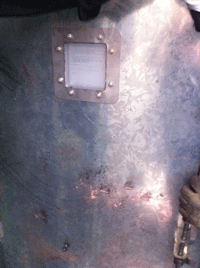
Chalfont, PA:
Several manufacturers of Arc Resistant ("AR") switchgear and motor control centers (MCCs) have included the ExiscanTM XIR series IR window in arc resistance tests to prove that the windows do not degrade the protective features of the AR equipment. A major manufacturer of Arc Resistant switchgear recently allowed ExiscanTM engineers to witness one such Arc Resistance Test at KEMA Power Test in Calfont, PA. The test complied with the ANSI/IEEE C37.20.7 Arc Resistance Test procedures.
Prior to the test, the ExiscanTM XIR-A-4-H infrared window was attached to the enclosure door, roughly in the middle of one of the cable compartments -- a typical position for an IR window. The ignition source was roughly 18 inches from the enclosure door and roughly 15 inches off the bottom of the enclosure. The arc was initiated using a thin gauge wire across phases. Cotton flags were mounted 1” from the seams of the enclosure and around the window. Any escape of heated gases from inside the enclosure would ignite the flags, indicating a failure to contain the arc energy.

Upon review of the window after the arc test, the enclosure panel to which the window was attached showed some deformation, however, the IR window’s over-sized-stainless steel backer-plate kept the window mounting surface flat, allowing the inspection window to maintain a flush seal to the enclosure, thereby retaining the heated gases.
Inspection of the cotton flags after the test showed no signs of exposure to the heated gases, and no burn marks were evident outside the window on the enclosure skin. Upon opening the enclosure, and inspecting the window optic, the optic was still in tact and showed no signs of structural deterioration. This is not to be expected in every case, but was notable in this and other AR tests. Just below the window one can see evidence of molten shrapnel from the copper conductors that hit the enclosure door and then cooled.
The switchgear successfully contained and redirected the energy from the blast within roughly 30 mili-seconds: the system (switchgear with infrared window attached) passed the test.
It should be stressed that this test was performed in a professional testing laboratory, on Arc Resistant switchgear -- switchgear that has been engineered to retain and redirect the effects of the arc flash. Although the XIR-A-4 series IR window was on the switchgear during the test, no accessory (such as an IR window) can be said to be certified as "Arc Resistant" regardless of what any manufacturer might claim.
Arc Resistance tests are tests of the entire system which not only includes the IR window, but also, and most notably, includes the vents, plenums, etc. that redirect the arc energy (heat and blast forces) away from the switchgear doors, and out out into a secured area. As a result, the blast pressure hitting the window is only about 30 PSI! Make no mistake, by redirecting the arc energy, it is the engineering of the switchgear, not the window, that is making it possible for the switchgear to pass this test of an extremely violent explosion.
Standard (that is "non-Arc-Resistant") switchgear is not outfitted with systems that redirect the arc energy. Therefore, the blast forces impacting the doors and windows can be 10 to 20 times higher than they are on Arc Resistant switchgear -- in other words, windows on standard switchgear are not being hit with 30 PSI, but rather with 300 to 600 PSI or more! The pressures and heat involved under similar conditions on standard switchgear would yield significantly different results. That is why Exiscan does not engineer its IR inspection windows to pass tests where the arc energy is mitigated and redirected. Frankly, it's not a very high bar.
ExiscanTM engineers it's IR windows (and other inspection windows) to outlive the equipment to which it is attached. By doing so, ExiscanTM inspection windows allow the switchgear operate the way it was designed -- either to redirect the blast (for Arc Resistant equipment), or to fail the way it was designed to fail (in the event of standard equipment). To understand how we can make our windows outlive your enclosure, you have to hold an ExiscanTM IR window:
- The cover and body are machined from 1/2" bar stock aluminum or stainless steel
- The base is anchored by eight stainless steel studs
- The studs then bolt through an additional 16 gauge stainless steel backer plate for addicted strength and rigidity
Next time a salesman brags in a misguided manner about their "Arc Resistant" IR Window, please tell them that there is no such thing, and then ask them why they are so impressed about holding back 30 PSI. Tell them you want a window designed to a higher standard.
(Tim Rohrer, President and Founder of Exiscan, is a member of the working groups for the IEEE C37.20.7 Guide for Testing Switchgear Rated Up to 38kV for Internal Arcing Faults, commonly referred to as the "Arc Resistance Test Standard.")
